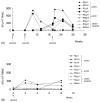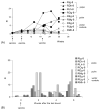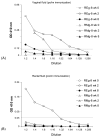Live attenuated Listeria monocytogenes expressing HIV Gag: immunogenicity in rhesus monkeys
- PMID: 17854955
- PMCID: PMC2518091
- DOI: 10.1016/j.vaccine.2007.08.013
Live attenuated Listeria monocytogenes expressing HIV Gag: immunogenicity in rhesus monkeys
Abstract
Induction of strong cellular immunity will be important for AIDS vaccine candidates. Natural infection with wild-type Listeria monocytogenes (Lm), an orally transmitted organism, is known to generate strong cellular immunity, thus raising the possibility that live attenuated Lm could serve as a vaccine vector. We sought to examine the potential of live attenuated Lm to induce cellular immune responses to HIV Gag. Rhesus macaques were immunized with Lmdd-gag that expresses HIV gag and lacks two genes in the D-alanine (D-ala) synthesis pathway. Without this key component of the bacterial cell wall, vaccine vector replication critically depends on exogenous D-ala. Lmdd-gag was given to animals either solely orally or by oral priming followed by intramuscular (i.m.) boosting; D-ala was co-administered with all vaccinations. Lmdd-gag and D-ala were well tolerated. Oral priming/oral boosting induced Gag-specific cellular immune responses, whereas oral priming/i.m. boosting induced systemic as well as mucosal anti-Gag antibodies. These results suggest that the route of vaccination may bias anti-Gag immune responses either towards T-helper type 1 (Th1) or Th2 responses; overall, our data show that live attenuated, recombinant Lmdd-gag is safe and immunogenic in primates.
Figures





Similar articles
-
A live attenuated Listeria monocytogenes vaccine vector expressing SIV Gag is safe and immunogenic in macaques and can be administered repeatedly.Vaccine. 2011 Jan 10;29(3):476-86. doi: 10.1016/j.vaccine.2010.10.072. Epub 2010 Nov 9. Vaccine. 2011. PMID: 21070847 Free PMC article.
-
Novel vaccination protocol with two live mucosal vectors elicits strong cell-mediated immunity in the vagina and protects against vaginal virus challenge.J Immunol. 2008 Feb 15;180(4):2504-13. doi: 10.4049/jimmunol.180.4.2504. J Immunol. 2008. PMID: 18250460
-
Engineered Listeria monocytogenes as an AIDS vaccine.Vaccine. 2002 May 6;20(15):2007-10. doi: 10.1016/s0264-410x(02)00088-9. Vaccine. 2002. PMID: 11983264 Review.
-
Induction of human immunodeficiency virus (HIV)-specific CD8 T-cell responses by Listeria monocytogenes and a hyperattenuated Listeria strain engineered to express HIV antigens.J Virol. 2000 Nov;74(21):9987-93. doi: 10.1128/jvi.74.21.9987-9993.2000. J Virol. 2000. PMID: 11024127 Free PMC article.
-
Live virus vaccines based on a vesicular stomatitis virus (VSV) backbone: Standardized template with key considerations for a risk/benefit assessment.Vaccine. 2016 Dec 12;34(51):6597-6609. doi: 10.1016/j.vaccine.2016.06.071. Epub 2016 Jul 6. Vaccine. 2016. PMID: 27395563 Free PMC article. Review.
Cited by
-
Intranasal vaccination with the recombinant Listeria monocytogenes ΔactA prfA* mutant elicits robust systemic and pulmonary cellular responses and secretory mucosal IgA.Clin Vaccine Immunol. 2011 Apr;18(4):640-6. doi: 10.1128/CVI.00254-10. Epub 2011 Jan 26. Clin Vaccine Immunol. 2011. PMID: 21270282 Free PMC article.
-
Mucosal immunity and protection against HIV/SIV infection: strategies and challenges for vaccine design.Int Rev Immunol. 2009;28(1):20-48. doi: 10.1080/08830180802684331. Int Rev Immunol. 2009. PMID: 19241252 Free PMC article. Review.
-
Self-adjuvanting bacterial vectors expressing pre-erythrocytic antigens induce sterile protection against malaria.Front Immunol. 2013 Jul 4;4:176. doi: 10.3389/fimmu.2013.00176. eCollection 2013. Front Immunol. 2013. PMID: 23847617 Free PMC article.
-
Live bacterial vaccine vectors: an overview.Braz J Microbiol. 2015 Mar 4;45(4):1117-29. doi: 10.1590/s1517-83822014000400001. eCollection 2014. Braz J Microbiol. 2015. PMID: 25763014 Free PMC article. Review.
-
A Promising Listeria-Vectored Vaccine Induces Th1-Type Immune Responses and Confers Protection Against Tuberculosis.Front Cell Infect Microbiol. 2017 Sep 28;7:407. doi: 10.3389/fcimb.2017.00407. eCollection 2017. Front Cell Infect Microbiol. 2017. PMID: 29034213 Free PMC article.
References
-
- Baba TW, Liska V, Hofmann-Lehmann R, Vlasak J, Xu W, Ayehunie S, et al. Human neutralizing monoclonal antibodies of the IgG1 subtype protect against mucosal simian-human immunodeficiency virus infection. Nat Med. 2000;6(2):200–6. - PubMed
-
- Ferrantelli F, Hofmann-Lehmann R, Rasmussen RA, Wang T, Xu W, Li PL, et al. Post-exposure prophylaxis with human monoclonal antibodies prevented SHIV89. 6P infection or disease in neonatal macaques AIDS. 2003;17(3):301–9. - PubMed
-
- Ferrantelli F, Rasmussen RA, Buckley KA, Li PL, Wang T, Montefiori DC, et al. Complete protection of neonatal rhesus macaques against oral exposure to pathogenic simian-human immunodeficiency virus by human anti-HIV monoclonal antibodies. J Infect Dis. 2004;189(12):2167–73. - PubMed
Publication types
MeSH terms
Substances
Grants and funding
LinkOut - more resources
Full Text Sources

